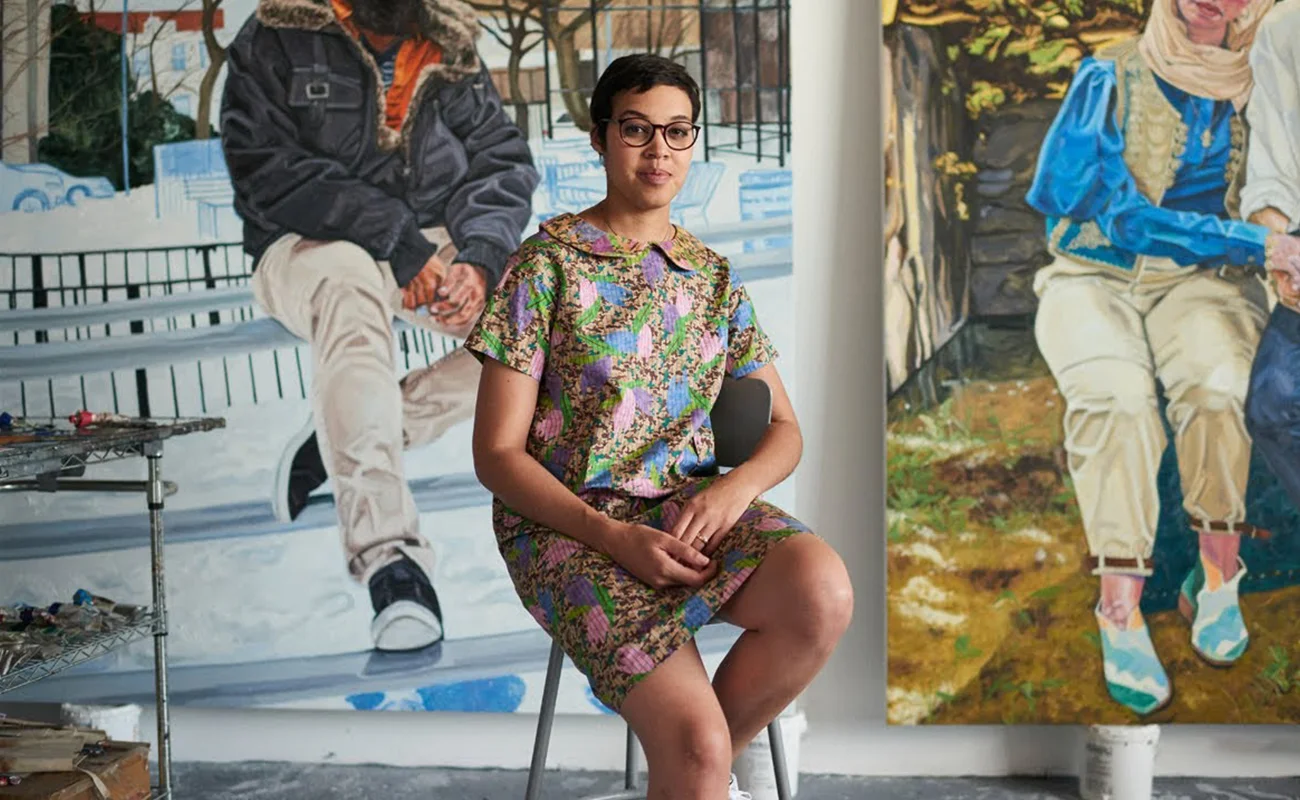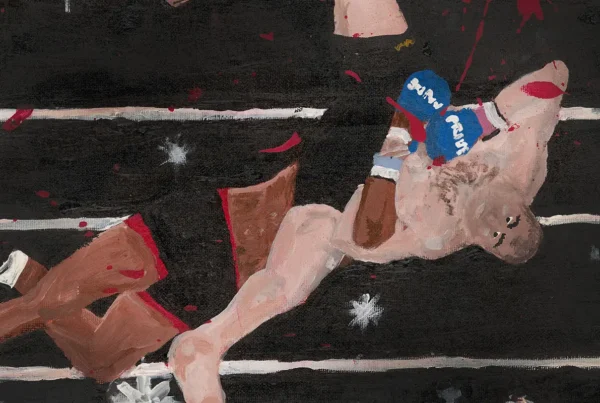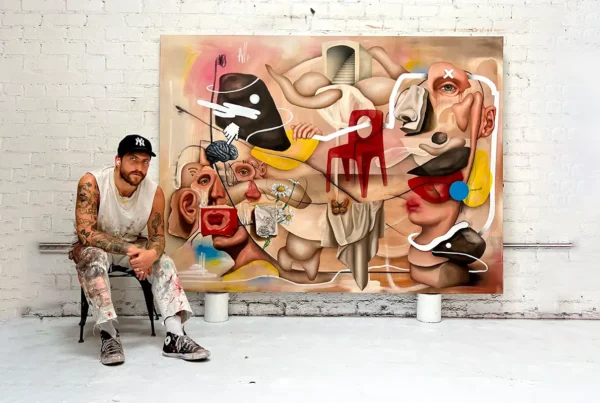Capturing the Essence of Humanity Through Color and Form
From the serene landscapes of Denver, Colorado, to the bustling streets of Harlem, New York, Jordan Casteel‘s artistic journey is a profound narrative of self-discovery and expression. Growing up in an environment where art was a vibrant presence, Casteel’s early life in Denver was deeply intertwined with creativity. Her home, a sanctuary of artistic influence, boasted works by luminaries like Romare Bearden and Hale Woodruff. This early immersion in the arts, nurtured by her grandmother’s active role in the art community and her own explorations in various art classes, laid the foundation for Casteel’s deep-rooted connection to art. The landscapes of Denver, with their inherent tranquility, played a significant role in shaping her dreamer’s spirit, a quality that would later permeate her artistic endeavors.
This nurturing environment set the stage for Casteel’s transition from a potential practical career path to a wholehearted commitment to art. Initially juggling her passion for painting with a teaching career, a moment of clarity in a therapy session catalyzed her decision to pursue art full-time. This pivotal decision led her to further her studies in the prestigious halls of Yale University, where her artistic voice and unique approach to portraiture began to crystallize. Yale not only expanded her technical skills and conceptual horizons but also deepened her focus on portraiture, particularly her nuanced portrayal of black men, which became a defining element of her work.

Jordan Casteel: Embracing Community Through Artistic Engagement
The transition from the academic environment of Yale to the vibrant cultural landscape of Harlem marked a significant chapter in Casteel’s career. Her residency at The Studio Museum in Harlem was not merely a change of location; it was an immersion into a community rich in stories and diversity, which profoundly influenced her artistic direction. Harlem’s dynamic environment became a canvas for Casteel, allowing her to explore and articulate themes of Black masculinity and community. Her approach evolved into a near-anthropological methodology, where the process of painting transformed from mere observation to active engagement, turning her subjects from strangers into collaborators.
Casteel’s artistic practice is distinguished by her vibrant use of color and her intimate portrayal of her subjects. She employs color not as a mere representational tool but as a medium to explore and question identity, perception, and emotion, particularly in the context of blackness. Her choice of colors, often abstracted from reality, aims to convey a deeper, more personal truth, capturing the essence of her subjects beyond the superficial. This meticulous process, involving photography and drawing, allows Casteel to delve into the individual stories and humanity of her subjects, making each portrait a unique narrative of its own.
Beyond the canvas, Casteel views her art as a conduit for community building and dialogue. Each portrait extends beyond its frame, creating a network of relationships and conversations that underscore her belief in the unifying power of art. This commitment to community and empathy is a testament to Casteel’s philosophy that art is not just a form of expression but a means to foster understanding and connection among people.
Through her vivid use of color, empathetic engagement with her subjects, and deep commitment to community, Jordan Casteel continues to inspire and challenge the norms of contemporary portraiture. Her journey, from the inspirations of Denver to the transformative experiences at Yale and Harlem, reflects a continuous exploration of identity, humanity, and the power of art to bridge diverse worlds.

The Transformative Power of Education and Experience
Jordan Casteel’s educational journey, particularly her time at Yale University, served as a transformative period that honed her artistic voice and approach to her craft. At Yale, Casteel was not just a student; she was an artist in the making, absorbing a diverse range of perspectives and refining her technique. This environment fostered her growth, pushing her to articulate her vision in a language uniquely her own. The rigorous academic and creative challenges she faced at Yale expanded her understanding of art, enabling her to experiment and find new dimensions in her work. It was here that her focus on portraiture gained depth, influenced by personal experiences and the broader societal context, particularly her nuanced exploration of black masculinity.
The impact of Yale extended beyond technical skills and conceptual frameworks; it instilled in Casteel a profound sense of purpose and direction. Her experiences there shaped not just her artistic techniques but also her philosophical approach to art. She emerged from Yale with a reinforced commitment to using her art as a means of communication, a way to explore and express complex identities and stories. This period of intense growth and discovery was crucial in defining Casteel’s role as an artist committed to portraying the intrinsic humanity and individuality of her subjects.

Jordan Casteel: New York, Harlem, and the Pulse of Community Life
The move to New York City, particularly her residency at The Studio Museum in Harlem, marked a pivotal moment in Casteel’s artistic career. This transition was not merely geographical but also a deep dive into a new cultural and social milieu that would profoundly influence her work. Harlem, with its rich history and vibrant community life, provided Casteel with an endless source of inspiration and narrative. The Studio Museum in Harlem, known for its role in nurturing artists of African descent, offered her a unique platform to explore her artistic interests in the context of a broader cultural and historical dialogue.
During her residency, Casteel’s engagement with the community of Harlem became a central element of her artistic practice. She didn’t just observe; she immersed herself, creating art that was a dialogue with the community. This interaction was a key factor in the evolution of her portraiture, which increasingly focused on capturing the essence of community life and the individual stories within it. Harlem became a lens through which Casteel examined broader themes of identity, community, and representation, integrating the personal and the collective in her vibrant, emotive canvases.
Through her educational experiences and her immersive engagement with the Harlem community, Jordan Casteel has carved a distinctive path in the world of contemporary art. Her journey underscores the power of education and community engagement in shaping an artist’s voice and vision. Casteel’s work, deeply rooted in personal and communal narratives, continues to resonate with audiences, offering a profound commentary on the human experience. Her trajectory from the academic halls of Yale to the lively streets of Harlem encapsulates her evolution as an artist who not only captures life on canvas but also profoundly engages with the world around her.






